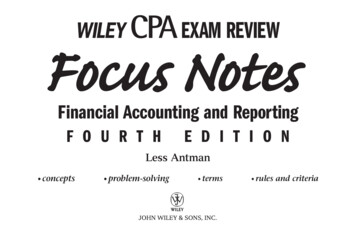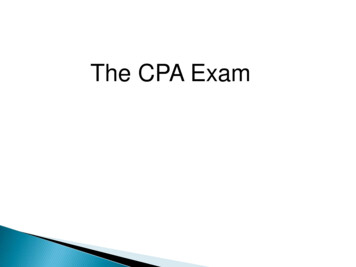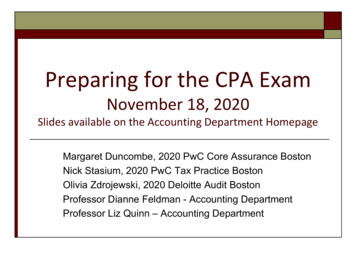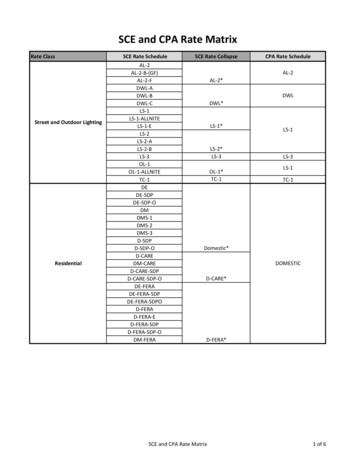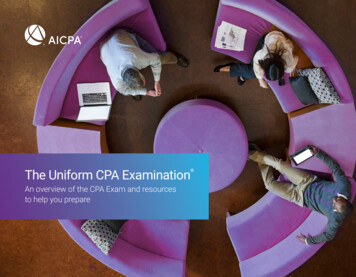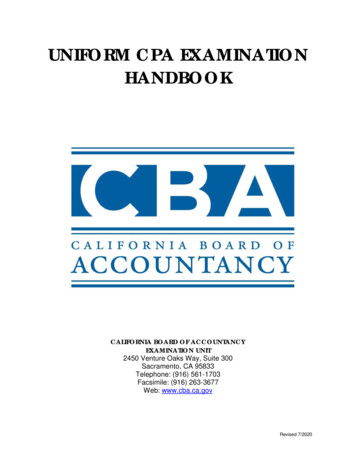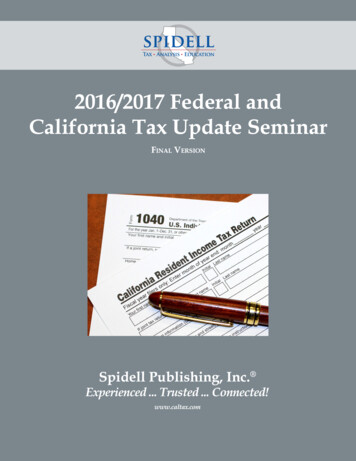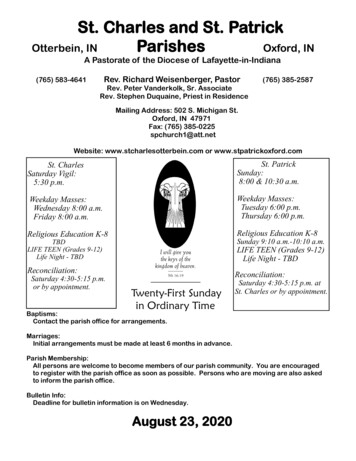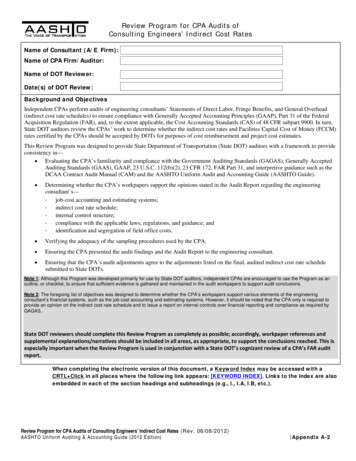
Transcription
Review Program for CPA Audits ofConsulting Engineers’ Indirect Cost RatesName of Consultant (A/E Firm):Name of CPA Firm/Auditor:Name of DOT Reviewer:Date(s) of DOT Review:Background and ObjectivesIndependent CPAs perform audits of engineering consultants’ Statements of Direct Labor, Fringe Benefits, and General Overhead(indirect cost rate schedules) to ensure compliance with Generally Accepted Accounting Principles (GAAP), Part 31 of the FederalAcquisition Regulation (FAR), and, to the extent applicable, the Cost Accounting Standards (CAS) of 48 CFR subpart 9900. In turn,State DOT auditors review the CPAs’ work to determine whether the indirect cost rates and Facilities Capital Cost of Money (FCCM)rates certified by the CPAs should be accepted by DOTs for purposes of cost reimbursement and project cost estimates.This Review Program was designed to provide State Department of Transportation (State DOT) auditors with a framework to provideconsistency in— Evaluating the CPA’s familiarity and compliance with the Government Auditing Standards (GAGAS), Generally AcceptedAuditing Standards (GAAS), GAAP, 23 U.S.C. 112(b)(2), 23 CFR 172, FAR Part 31, and interpretive guidance such as theDCAA Contract Audit Manual (CAM) and the AASHTO Uniform Audit and Accounting Guide (AASHTO Guide). Determining whether the CPA’s workpapers support the opinions stated in the Audit Report regarding the engineeringconsultant’s—- job-cost accounting and estimating systems;- indirect cost rate schedule;- internal control structure;- compliance with the applicable laws, regulations, and guidance; and- identification and segregation of field office costs. Verifying the adequacy of the sampling procedures used by the CPA. Ensuring the CPA presented the audit findings and the Audit Report to the engineering consultant. Ensuring that the CPA’s audit adjustments agree to the adjustments listed on the final, audited indirect cost rate schedulesubmitted to State DOTs.Note 1: Although this Program was developed primarily for use by State DOT auditors, independent CPAs are encouraged to use the Program as anoutline, or checklist, to ensure that sufficient evidence is gathered and maintained in the audit workpapers to support audit conclusions.Note 2: The foregoing list of objectives was designed to determine whether the CPA’s workpapers support various elements of the engineeringconsultant’s financial systems, such as the job-cost accounting and estimating systems. However, it should be noted that the CPA only is required toprovide an opinion on the indirect cost rate schedule and to issue a report on internal controls over financial reporting and compliance as required byGAGAS.State DOT reviewers should complete this Review Program as completely as possible; accordingly, workpaper references andsupplemental explanations/narratives should be included in all areas, as appropriate, to support the conclusions reached. This isespecially important when the Review Program is used in conjunction with a State DOT’s cognizant review of a CPA’s FAR auditreport.When completing the electronic version of this document, a Keyword Index may be accessed with aCRTL Click in all places where the following link appears: [KEYWORD INDEX]. Links to the index are alsoembedded in each of the section headings and subheadings (e.g., I., I.A, I.B, etc.).Review Program for CPA Audits of Consulting Engineers’ Indirect Cost Rates (Rev. 06/08/2012)AASHTO Uniform Auditing & Accounting Guide (2012 Edition) Appendix A-2
Name of Consultant:Audit Period:CPA Firm/Auditor:DOT Reviewer:Review Date:REVIEW PROGRAM FOR CPA AUDITS OF CONSULTING ENGINEERS’ INDIRECT COST RATESI. PREPARATORY WORK FOR DOT REVIEWER.Completed?[KEYWORD INDEX]I.A.CURRENT INDIRECT COST RATE SCHEDULE. Obtain the indirect cost rateschedule for the engineering consultant’s most recently completed fiscal year.Yes. Comment:I.B.INDIRECT COST RATE SCHEDULES FROM PRIOR YEARS. Obtainprevious year(s) indirect cost rate schedule(s).Yes. Comment:I.C.ANALYTICAL PROCEDURES. Compare indirect cost rate schedules forconsistency of amounts, rates, and allocations to home office and field offices.Yes. Comment:I.D.GENERAL PURPOSE FINANCIAL STATEMENTS. Obtain copy of generalpurpose financial statements for the period being reviewed, if available, and/orForm 10K for publicly-traded companies (many times this can be obtainedfrom the company’s website). Review of the financial statements may provideadditional information regarding related party transactions, acquisition ofanother firm(s) or other organizational changes, and other information thatcould be used during the review of the CPA’s Audit Report.Yes. Comment:I.E.CPA-CLIENT RELATIONSHIP. Evaluate the length of time there has been abusiness relationship between the CPA and engineering consultant andwhether the CPA has a close relationship with any of the consultant’smanagement or other personnel. (In accordance with GAGAS 3.14.d and3.16, the CPA should employ safeguards to either eliminate threats ofindependence or reduce them to an acceptable level.)Yes. Comment:Review Program for CPA Audits of Consulting Engineers’ Indirect Cost Rates (Rev. 06/08/2012)AASHTO Uniform Auditing & Accounting Guide (2012 Edition) Appendix A-3
Name of Consultant:Audit Period:CPA Firm/Auditor:DOT Reviewer:Review Date:II. GAGAS GENERAL STANDARDS.Attribute Met?[KEYWORD INDEX]II.A.PEER REVIEW REPORT. Review the CPA’s most recent Peer ReviewReport. Did the CPA receive a Peer Review Rating of Pass (GAGAS 3.101)?If not, document the comments of the peer reviewer(s), obtain a copy of thecorrective action plan, and note any possible impairment(s) to the audit workperformed.YesNoII.B.CPE. Did the CPA meet the minimum Yellow Book requirements for CPEcredit per GAGAS 3.76? Review the earned CPE hours and course listing foreach individual CPA who worked on the assignment: 80 hours CPE over 2 years 24 hours in government auditing or government environmentYesNoII.C.INDEPENDENCE. Did it appear that the CPA was free from personal, external,and organizational impairments to independence, and did the CPA avoid theappearance of such impairments to independence (GAGAS 3.02 through3.30)?YesNoII.D.PEER REVIEW REPORT. (Answer “yes” or “no,” based on overallconclusion.) Did the staff assigned to conduct the audit collectively possessadequate professional competence for the tasks required (GAGAS 3.69through 3.75)? Determine the sufficiency of CPA firm’s knowledge ofapplicable audit criteria, such as the following: Were staff members assigned to the audit proficient with the FAR? Were assigned staff members knowledgeable of the AASHTO Guideand other relevant guidance (e.g., the DCAA CAM and/orsupplemental materials issued by State DOTs?) Have assigned staff members received specific training in relevantsubjects? Has the firm had recent experience in conducting FAR audits? Have any State DOTs already reviewed any of the CPA’s audits ofother consulting firms? If “yes,” the DOT reviewer should contactthose states to see if they identified any problems with the CPA’swork.YesNoReview Program for CPA Audits of Consulting Engineers’ Indirect Cost Rates (Rev. 06/08/2012)AASHTO Uniform Auditing & Accounting Guide (2012 Edition)CPA WorkpaperReference(or Comment)[KEYWORD INDEX] Appendix A-4
Name of Consultant:Audit Period:CPA Firm/Auditor:DOT Reviewer:Review Date:III. GAGAS FIELD WORK STANDARDS.Attribute Met?[KEYWORD INDEX]III.A.PLANNING. (Answer “yes” or “no,” based on overall conclusion.) Is thereevidence that the audit work was properly planned to: Determine the nature timing and extent of auditing procedures; Consider fraud and illegal acts; Consider materiality; Evaluate previous audits; and Assess risk?III.B.ENGAGEMENT LETTER. Did the audit contract, engagement letter, oragreement include the following? (Answer “yes” or “no,” based onoverall conclusion.) The period to be covered, The cost pools to be audited, The reports to be prepared, That representatives of State agencies and other applicableGovernment audit staff shall have access to the audit documentationupon request and in a timely manner (GAGAS 4.16), That working papers be maintained for at least three years after thedate of the report, Any restrictions or special conditions, and Citations to the Audit Guide and other relevant standards and/orregulations to be followed (e.g., GAGAS, GAAS, and FAR Part 31)?YesNoN/AIII.C.PRIOR FINDINGS. Did the CPA follow up on known material findings andrecommendations from prior audits (GAGAS 4.05)?YesNoN/AReview Program for CPA Audits of Consulting Engineers’ Indirect Cost Rates (Rev. 06/08/2012)AASHTO Uniform Auditing & Accounting Guide (2012 Edition)YesWorkpaperReference(or Comment)No Appendix A-5
Name of Consultant:Audit Period:CPA Firm/Auditor:DOT Reviewer:Review Date:III. GAGAS FIELD WORK STANDARDS.III.D.QUALITY OF AUDIT DOCUMENTATION. Did the audit documentation(GAGAS 4.15 and 5.16) provide adequate evidence of the following? Overall, there was sufficient detail to provide a clear understanding ofthe CPA’s work (additional detail, supplementary, or oralexplanations should not be necessary); The audit evidence obtained included its source, descriptions oftransactions and records examined, and the conclusions reached; The documentation provided sufficient detail to enable anexperienced auditor, having no previous connection to the audit, tounderstand—– the nature, timing, and extent of auditing proceduresperformed to comply with Yellow Book and otherapplicable standards and requirements;– the results of the audit procedures performed and theaudit evidence obtained;– the conclusions reached on significant matters; and– the accounting records agree or reconcile with theaudited financial statements or other auditedinformation. The documentation provided evidence of supervisory review ofthe work performed (GAGAS 4.15).IV. FORMAT AND CONTENTS OF AUDIT REPORT.Attribute Met?[KEYWORD INDEX]YesNoYesNoYesNoYesNoAttribute Met?[KEYWORD INDEX]IV.A.AUDIT OPINION. Did the report contain an opinion stating that the auditedindirect cost rate schedule was fairly presented in accordance with applicableFederal laws and regulations?YesNoIV.B.SCOPE. Did the report contain a scope paragraph stating that the audit wasperformed in accordance with Yellow Book standards?YesNoReview Program for CPA Audits of Consulting Engineers’ Indirect Cost Rates (Rev. 06/08/2012)AASHTO Uniform Auditing & Accounting Guide (2012 Edition)WorkpaperReference(or Comment)WorkpaperReference(or Comment) Appendix A-6
Name of Consultant:Audit Period:CPA Firm/Auditor:DOT Reviewer:Review Date:IV. FORMAT AND CONTENTS OF AUDIT REPORT.IV.C.BASIS FOR DETERMINING ELIGIBLE/ALLOWABLE COSTS. Did the scopeparagraph state that the CPA used FAR Part 31 as the primary basis fordetermining costs eligible for reimbursement under Government contracts?IV.D.REPORT ON INTERNAL CONTROLS. Did the CPA issue a report on theInternal Control and Compliance with Laws, Regulations, and Provisions ofContracts or Grant Agreements as required by Government Auditing Standards(GAGAS 4.19 - 4.22)?– If “yes,” were all significant deficiencies and material weaknesses inthe internal control that were found by the auditor disclosed in theauditor’s report? (GAGAS 4.23 - 4.39)IV.E.COMMUNICATION OF RESULTS OF AUDIT. Review the procedures used bythe CPA to communicate the results of the audit and deficiencies in internalcontrols to the engineering consultant (GAGAS 4.23 - 4.29). Were theprocedures adequate?Review Program for CPA Audits of Consulting Engineers’ Indirect Cost Rates (Rev. 06/08/2012)AASHTO Uniform Auditing & Accounting Guide (2012 Edition)Attribute Met?[KEYWORD INDEX]YesNoYesYesN/ANoNoYesWorkpaperReference(or Comment)N/ANo Appendix A-7
Name of Consultant:Audit Period:CPA Firm/Auditor:DOT Reviewer:Review Date:IV. FORMAT AND CONTENTS OF AUDIT REPORT.IV.F.DISCLOSURE NOTES. (Answer “yes” or “no,” based on overallconclusion.) Were the Disclosure Notes to the Report Adequate? (SeeAASHTO Guide, Chapter 11, which discusses Audit Reports and MinimumDisclosures.)Attribute Met?[KEYWORD INDEX]YesWorkpaperReference(or Comment)NoAt a minimum, the following should have been disclosed (if applicable): Description of the Company (11.4.A) Basis of Accounting (11.4.B) Description of Accounting Policies, including Cost AllocationPolicies (11.4.C). Description of Overhead Rate Structure (11.4.D).- Reporting unit;- Single base or multiple bases, and how the base(s) is (are) applied. Description of Labor Related Costs (11.4.E). Such as:- Policies regarding the allocation of project labor (e.g., actual vs.standard hourly rates and, if applicable, how and when are variancescomputed and recorded);- Contract/Purchased Labor;- Paid Time Off;- Paid Overtime & Uncompensated Overtime (e.g., how is overtimepremium treated, and how does the company account ofuncompensated overtime), Executive Compensation Analysis,Pension/Deferred Compensation, and Employee Stock Option Plans. Description of Depreciation and Leasing Policies (11.4.F) Description of Related-Party Transactions (11.4.G) Facilities Capital Cost of Money (FCCM) (11.4.H) List of Direct Cost Accounts (11.4.I).- Were direct costs consistently allocated to cost objectives/projects?- Were individual charge-rates (if applicable) listed, along with alongwith a general description of the audit procedures used to verify theaccuracy of the rates?[KEYWORD INDEX] IV.G.Management’s Evaluation of Subsequent Events (11.4.J). Was astatement included noting that the company has adequatelyconsidered the effect of subsequent events up to the date the indirectcost rate schedule was issued?ELEMENTS OF AUDIT REPORT. Did the CPA’s Audit Report contain a listof costs submitted by the engineering consultant, adjustments and allowedcosts per audit, explanations of the adjustments, and FAR references for theadjustments made?Review Program for CPA Audits of Consulting Engineers’ Indirect Cost Rates (Rev. 06/08/2012)AASHTO Uniform Auditing & Accounting Guide (2012 Edition)YesNo Appendix A-8
Name of Consultant:Audit Period:CPA Firm/Auditor:DOT Reviewer:Review Date:V. REVIEW OF CPA’s AUDIT TESTING(Application of GAGAS, FAR Part 31, and relevant Cost AccountingStandards (48 CFR Chapter 99))V.A.1V.A.2GENERAL LEDGER. (Answer “yes” or “no,” based on overallconclusion.)Did the CPA review the accounting system to determine if the system wasadequate to segregate and accumulate reasonable, allocable, and allowablecosts? Evaluate the testing used by the CPA to verify the accuracy of costsin the general ledger, associated subsidiary ledgers, and relateddocuments or systems. (Assess if testing was sufficient to support theCPA’s conclusions—consider additional sample testing, ifnecessary). Was there evidence that costs in the general ledger were properlyclassified? Did the general ledger contain separate accounts for segregatingFAR-unallowable costs? If not, were unallowable costs otherwise identified or estimated?Review, evaluate, and document how the unallowable costs weredetermined. Review the CPA’s documentation of tests andconclusions.GENERAL LEDGER (continued). (Answer “yes” or “no,” based onoverall conclusion.)If the engineering consultant used statistical sampling as a basis toestimate unallowable costs, was a proper statistical sampling methodused as required by FAR 31.201-6(c)(2)? Specifically: The sampling method must result in an unbiased sample that is areasonable representation of the sampling universe; Any large dollar value or high risk transaction must be separatelyreviewed for unallowable costs and must be excluded from thesampling process; and The sampling method must permit audit verification. Did the engineering consultant enter into an appropriate advanceagreement with its cognizant State DOT to allow for such samplingand estimation as discussed in FAR 31.201-6(c)(4)?Review Program for CPA Audits of Consulting Engineers’ Indirect Cost Rates (Rev. 06/08/2012)AASHTO Uniform Auditing & Accounting Guide (2012 Edition)Attribute Met?[KEYWORD INDEX]YesWorkpaperReference(or Comment)No[KEYWORD INDEX]YesNoN/A Appendix A-9
Name of Consultant:Audit Period:CPA Firm/Auditor:DOT Reviewer:Review Date:V. REVIEW OF CPA’s AUDIT TESTING(Application of GAGAS, FAR Part 31, and relevant Cost AccountingStandards (48 CFR Chapter 99))V.B.Attribute Met?[KEYWORD INDEX]WorkpaperReference(or Comment)LABOR ACCOUNTING SYSTEM. (See AASHTO Guide, Chapters 6 and 10.)Did the CPA’s workpapers contain evidence that the engineeringconsultant’s labor-charging/timekeeping system was determined to becomplete and sufficiently detailed to allow for a proper determination of theconsultant’s direct labor base and indirect labor costs, including theallowability of such costs? Specifically— Was there evidence that the consultant accounted for all hoursworked by all employees, including salaried employees andprincipals?YesNoWas there evidence that indirect labor was recorded on timesheets insufficient detail to allow for a determination of labor relating to FARgoverned costs, including marketing/promotional, direct selling, bidand proposal, training, reorganization, and other administrative tasks?YesNoWere the labor costs per the indirect cost rate schedule reconciled tototal labor costs per payroll tax returns (941s), the generalledger/financial statement, and the labor distributionsystem/summary?YesNoYesNoYesNoWas there a labor distribution analysis—a review of hours and ratesper the labor distribution reports and comparison to employeetimesheets and payroll register or other payroll records?Was there a review of uncompensated overtime? (FAR 52.237-10defines uncompensated overtime as “hours worked withoutadditional compensation in excess of an average of 40 hours perweek by direct charge employees who are exempt from the FairLabor Standards Act. Compensated personal absences such asholidays, vacations, and sick leave must be included in the normalwork week for purposes of computing uncompensated overtimehours.”)Review Program for CPA Audits of Consulting Engineers’ Indirect Cost Rates (Rev. 06/08/2012)AASHTO Uniform Auditing & Accounting Guide (2012 Edition) Appendix A-10
Name of Consultant:Audit Period:CPA Firm/Auditor:V.B.(cont.)LABOR ACCOUNTING SYSTEM (cont.)(See AASHTO Guide, Chapters 6 and 10.)DOT Reviewer:Review Date:[KEYWORD INDEX] If the consultant used a standard costing system, was there evidencethat the consultant properly accumulated and disposed of variances?YesNo Was there evidence that the consultant accounted for the premiumportion of overtime on a consistent basis?YesNo Was there evidence that the consultant consistently and properlyaccounted for project-related purchased/temporary labor?YesNo Did the CPA’s workpapers contain evidence that a minimum laborsample size of 26 timesheets1 were chosen for testing across anappropriate mix of direct-charge employees, including supervisorsand/or project managers? Alternatively, did the CPA’s workpapersfor labor testing document the size of the labor population and theconclusions drawn from the risk assessment to determine if a largersample size was warranted beyond the minimum sample size?YesNo1Generally, the testing should include all the time transactions (each increment of time allocated to a direct or indirect project or costpool) from the sampled timesheets.Review Program for CPA Audits of Consulting Engineers’ Indirect Cost Rates (Rev. 06/08/2012)AASHTO Uniform Auditing & Accounting Guide (2012 Edition) Appendix A-11
Name of Consultant:Audit Period:CPA Firm/Auditor:DOT Reviewer:Review Date:V. REVIEW OF CPA’s AUDIT TESTING(Application of GAGAS, FAR Part 31, and relevant Cost AccountingStandards (48 CFR Chapter 99))V.C.Attribute Met?[KEYWORD INDEX]WorkpaperReference(or Comment)PROJECT-COSTING/JOB-COSTING SYSTEM. Was there evidence thatthe project costing system accounted for all direct costs (direct labor andother costs that can be identified specifically with a project or final costobjective), on a proper, complete, and consistent basis? Did costs contained in the project costing system integrate with, orotherwise reconcile to, financial accounting system control accounts(general ledger accounts)?YesNo Was there evidence that the consultant properly recorded all directlabor to projects, including non-billable labor identified withprojects?YesNoWas there evidence that the consultant recorded labor costs atproperly developed labor rates for both salaried and non-salariedemployees? For example, did the CPA pay specific attention to theaccuracy of labor rates for salaried employees who incur overtimeand work in both direct and indirect functions?YesNoWas there evidence that the consultant recorded all Other DirectCosts, whether billable or not, to projects on a consistent basis? Werethe components of such costs segregated from general overhead?YesNo Did the workpapers address costs that the consultant treated as directcosts and billed, but also included in the indirect cost pool? If so:––Were recoveries associated with these costs credited tothe indirect cost pool in accordance withFAR 31.201-5?The netting of direct costs included in the indirect costpool and billed amounts (on a basis other than cost) inthis instance may yield an inaccurate representation ofcosts. Did the workpapers address the acceptability ofthis alternative methodology?Review Program for CPA Audits of Consulting Engineers’ Indirect Cost Rates (Rev. 06/08/2012)AASHTO Uniform Auditing & Accounting Guide (2012 Edition)YesNoN/AYesNoN/AYesNoN/A Appendix A-12
Name of Consultant:Audit Period:CPA Firm/Auditor:DOT Reviewer:Review Date:V. REVIEW OF CPA’s AUDIT TESTING(Application of GAGAS, FAR Part 31, and relevant Cost AccountingStandards (48 CFR Chapter 99))V.D.DIRECT COSTS/VERIFICATION OF COMPANY IN-HOUSE RATES ANDDIRECT BILLINGS. Did the CPA’s workpapers include evidence of thefollowing? The consultant submitted a list of direct cost accounts and amounts[KEYWORD INDEX]for the CPA’s review.Attribute Met?[KEYWORD INDEX]YesNo The CPA reviewed the consultant’s direct cost accounts for[KEYWORD INDEX]consistency.YesNo The CPA ensured that all direct costs were removed from the indirectcost pool.YesNo The CPA reviewed the consultant’s in-house billing rates to ensure:YesNoYesNoIf the expenses were accumulated in separate clearingaccount(s), the indirect cost pool included only indirectusage?YesNoDid the CPA audit the in-house billing rates, compare the audited inhouse rates to the billing rates, and revise as necessary (e.g., CADDand in-house reproductions)?YesNoDid the CPA verify billings on other projects on a sample basis? (If aState project was tested, note project number and amount forinformation.) Did the CPA performed reconciliations of:YesNo––– Total usage (direct and indirect) was included in thedenominator?If expenses associated with the development of therate(s) were accumulated in the indirect cost pool, theindirect cost pool was reduced by the amount of directusage?–Hours charged on billings to timesheets,–Hourly rates billed to actual rates, and–Hourly rates billed to contract maximums?Review Program for CPA Audits of Consulting Engineers’ Indirect Cost Rates (Rev. 06/08/2012)AASHTO Uniform Auditing & Accounting Guide (2012 Edition)WorkpaperReference(or Comment) Appendix A-13
Name of Consultant:Audit Period:CPA Firm/Auditor:DOT Reviewer:Review Date:V. REVIEW OF CPA’s AUDIT TESTING(Application of GAGAS, FAR Part 31, and relevant Cost AccountingStandards (48 CFR Chapter 99))V.E.COST POOLING AND ALLOCATION METHODOLOGIES. (Answer “yes”or “no,” based on overall conclusion.)Attribute Met?[KEYWORD INDEX]YesWorkpaperReference(or Comment)NoDid the CPA’s workpapers include evidence that costs were properly andconsistently pooled and allocated to intermediate and final costobjectives? Was there evidence that the CPA addressed the propriety of themethodology used by the engineering consultant in allocating costscontained in intermediate cost pools (e.g., corporate expenses, fringebenefits, general and administrative, and service specific overheads)to the final indirect cost rate(s)? Specifically, did the CPA firm evaluate the homogeneity of the costpools and the relationship to the allocators used? Did the CPAconclude that the methodology resulted in an allocation of costs inrelation to the benefits accrued by the cost objectives? If the consultant developed indirect costs rates for more than oneregion, reporting unit, or engineering discipline, did the CPA addressthe propriety of the cost pooling and cost allocation methodologiesused? For Other Direct Costs that were internally-generated, did the CPAdetermine that related costs were properly segregated from thegeneral cost pool and were allocated to projects on a consistent basis? For Other Direct Costs that were internally-generated, accumulated inseparate cost pools, and allocated based on individual charge rates,did the CPA determine that the consultant properly adjustedfor/resolved material year-end variances resulting from the over- orunder-allocation of actual costs? For internally-generated costs such as company-owned vehicles,were such costs accumulated in separate cost pools when such costswere material in amount and had a material impact on the firm’sindirect cost rates (specifically when the firm has more than oneoverhead rate involving differentials in the amounts of servicespecific vehicle usage)?[KEYWORD INDEX][KEYWORD INDEX].Review Program for CPA Audits of Consulting Engineers’ Indirect Cost Rates (Rev. 06/08/2012)AASHTO Uniform Auditing & Accounting Guide (2012 Edition) Appendix A-14
Name of Consultant:Audit Period:CPA Firm/Auditor:DOT Reviewer:Review Date:V. REVIEW OF CPA’s AUDIT TESTING(Application of GAGAS, FAR Part 31, and relevant Cost AccountingStandards (48 CFR Chapter 99))V.F.Attribute Met?[KEYWORD INDEX]WorkpaperReference(or Comment)AUDIT TESTING, GENERALLY. Did the workpapers include evidence that the CPA determined thatcosts contained in the indirect cost rate schedule were supported bythe underlying books and records, as summarized by financialstatements, trial balances, tax returns (IRS Form 941s), and relatedschedules?YesNoDid the workpapers document the identification of large-dollar orsensitive (LDS) transactions that were removed/stratified forcomplete examination, including verification (vouching) to sourcedocuments? (AASHTO Guide Chapter 10).YesNoDid the workpapers document the sampling parameters used by theCPA if additional testing beyond the LDS items was warranted?(AASHTO Guide Chapter 10).Review Program for CPA Audits of Consulting Engineers’ Indirect Cost Rates (Rev. 06/08/2012)AASHTO Uniform Auditing & Accounting Guide (2012 Edition)YesNoN/A Appendix A-15
Name of Consultant:Audit Period:CPA Firm/Auditor:DOT Reviewer:Review Date:V. REVIEW OF CPA’s AUDIT TESTING(Application of GAGAS, FAR Part 31, and relevant Cost AccountingStandards (48 CFR Chapter 99))V.G.Attribute Met?[KEYWORD INDEX]WorkpaperReference(or Comment)AUDIT TESTING: SPECIFIC COST ELEMENTS. The CPA’s workpapersshould include evidence that the CPA evaluated the allowability (includingreasonableness) of types or groups of costs that have the greatest potentialimpact on the overhead rate. These costs include the following:(1) salary,(2) bonus/incentive compensation costs,(3) fringe benefits costs,(4) indirect labor, and(5) other indirect costs.See the following subsections for details.V.G.1EXECUTIVE COMPENSATION REVIEW. Did the CPA’s workpapers include evidence that the engineeringconsultant reviewed executive compensation for allocability andreasonableness in compliance with Chapter 7 of the AASHTOGuide? Specifically, did the consultant disclose the following foreach of the executives?Item 1: Employee/owner/officer first and last name or employee ID,Item 2: Position title.Item 3: Revenue responsibility (sales generated by each executive).Item 4: Total wages/salaries paid, including taxable fringe benefits.Item 5: Total bonuses paid.Item 6: Total employer contributions to defined contribution pensionplans (whether paid, earned, or otherwise accrued).Item 7: Total of Items 4 through 6, above.Item 8: The applicable reasonableness measure/amount from theconsultant’s analysis, or other benchmark, such as theapplicable amount from the National Compensation Matrix(NCM).Item 9: The excess compensation amount required to be disallowedfrom the indirect labor or bonus line item. [KEYWORD INDEX]YesNo[KEYWORD INDEX]Did the CPA:–Verify that the wages paid were for work performed inthe current year and did not constitute a retroactiveadjustment of prior years’ salaries or wages?–Verify that specific elements of compensation costswere allocable, allowable and reasonable incompliance with FAR part 31?Review Program for CPA Audits of Consulting Engineers’ Indirect Cost Rates (Rev. 06/08/2012)AASHTO Uniform Auditing & Accounting Guide (2012 Edition)YesNoYesNo Appendix A-16
Name of Consultant:Audit Period:CPA Firm/Auditor:V.G.1(cont.) DOT Reviewer:Review Date:[KEYWORD INDEX]Did the CPA:–Verify that the Consultant properly comparedexecutive compensation amounts to the benchmarksdiscussed previously in Item 8?YesNo–Verify that the Consultant either:(a) used nationally-published salary survey data toprepare the analysis? Check here, if applicable:or(b) applied the applicable amount from the NCM?YesNoCheck here, if applicable:––V.G.2Review the Consultant’s bonus/incentive compensationplan to ensure that objective, performance-basedcriteria were established, communicated to staff, andused in determining bonus amounts?YesNoN/AReview the Consultant’s bonus/incentive compensationplan to determine if any portion of the bonus paid wasa constructive dividend or other distribution of profits?YesNoN/AYesNoN/ASUPERIOR PERFORMANCE. (Answer “yes” or “no,” based on overallconclusion.) If the Consul
DCAA Contract Audit Manual (CAM) and the AASHTO Uniform Audit and Accounting Guide (AASHTO Guide). Determining whether the CPA’s workpapers support the opinions stated in the Audit
